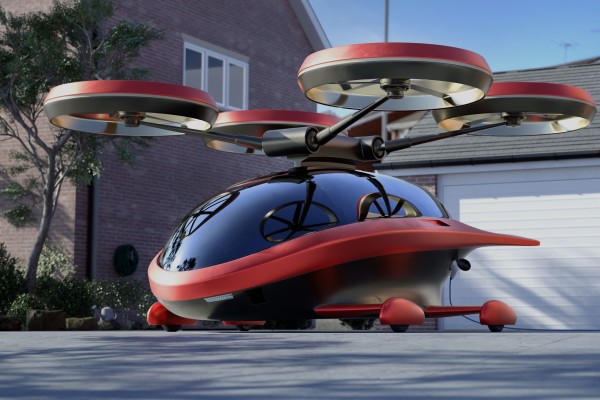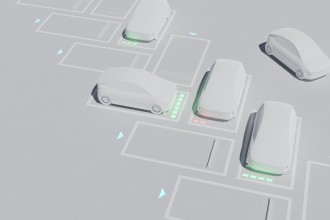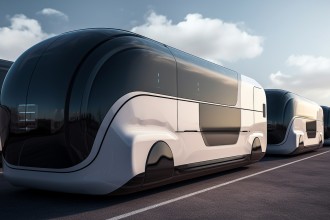-
-
2.1.Flying Taxis
-
2.2.Delivery Drones
-
2.4.Hyperloop
-
2.5.Smart Road
-
2.6.Smart Traffic Lights
-
What drives us to talk about transportation tech? ensun aims to speed up global business progress. Our web crawlers gather data, and our text-based algorithms organize it systematically. By combining our internal data with external sources, we offer insights into the latest technologies and spotlight the top innovators behind them.
For this report, we've analyzed over 455+ relevant companies within the transportation industry.
But first, let's clarify what transportation technologies are. These technologies refer to a wide range of tools, systems, and innovations designed to improve various aspects of transportation. According to Statista, “new technologies are disrupting traditional aviation as well as maritime transport”. They say that these have also led to investments in connected and autonomous vehicles.
With this understanding in mind, let’s dive into the latest trends shaping the transportation industry.
Forecasted Developments for Transportation Technology
The number of autonomous vehicles globally is projected to rise from about 17 thousand in 2022 to over 125 thousand in 2030. But how is this relevant for the overall industry? Let’s look at some numbers.
The American Truck Association reported a lack of 80 thousand drivers in 2021 and projected the numbers to double in less than 10 years. Meanwhile, this happens, truck tonnage is also expected to grow from 11.3 billion (2023) to 14.2 billion tons in 2034. In short, we will have fewer truckers for more loads that need to be transported. The numbers contradict each other.
This is where the new projected autonomous vehicles come into play. Autonomous trucks could at least partially, if not completely, solve the trucker shortage. Furthermore, we could even improve how our goods are transported. By being driverless, trucks could operate 24/7, only having to stop to charge their batteries. Safety could also be improved by reducing human error, which is a major factor in truck accidents.
However, there are still challenges to overcome before widespread adoption can be achieved. The technology for fully autonomous driving is still under development. Especially, its reliability and performance in diverse road conditions need further testing and refinement. Additionally, regulations governing autonomous vehicles on public roads are still being established. Public acceptance and trust in this technology are also crucial for its successful integration.
Overall, we can see even though there are obstacles, autonomous vehicles are going to be a big part of our future. But not only trucks will be autonomous, many companies are working on different means of transportation, which will also be driverless. This widespread adoption of autonomous vehicles has the potential to revolutionize how we receive our goods, potentially leading to faster deliveries and wider availability of products. In our daily lives, this could mean same-day delivery becoming commonplace, or even autonomous taxis offering a convenient and potentially cheaper transportation option.
Latest Transportation Technologies and Their Top Innovators
In recent years, transportation has seen a lot of changes caused by new technologies. Picture this: flying taxis soaring above busy city streets and delivery drones flying around to drop packages. But it doesn’t stop there. There are also hydrogen fuel cell vehicles and the exciting concept of hyperloop travel, where you can zoom through tunnels at incredible speeds. But don’t get us wrong. Transportation technologies are not just about going fast; there are also smart road technologies and smart traffic lights that improve the way of transportation with the help of continually advancing innovations. These emerging trends are promising and offering hope for are different and maybe brighter future.
So, let's take a closer look at very promising technological trends.
Flying Taxis
Flying taxis, which are part of urban air mobility, capture the attention of cities worldwide. Los Angeles, Brisbane (Australia) and Houston are among those considering incorporating air taxis into their urban transportation networks.
These innovative aircraft, resembling small commercial planes, offer convenient on-demand short flights to passengers. With the projections suggesting there could be up to 50,000 operational air taxis globally by 2040, the future of urban mobility seems destined for remarkable advancement.
As cities seek sustainable and efficient transportation solutions, flying taxis emerge as a promising option for reducing congestion and shortening travel times. The vision of a sky filled with air taxis ferrying passengers to their destinations is becoming increasingly tangible.
Top Innovators
- Wisk operates autonomously with a mission to realize the vision of providing safe, everyday flight for all.
- Volocopter is gearing up to launch electric air taxis in urban areas by 2024 and is actively recruiting experts to join their pioneering endeavor.
- Archer Aviation is pioneering urban air mobility to redefine everyday travel, focusing on innovative, efficient, and sustainable transportation. They are committed to transparent communication and data-driven strategies to successfully achieve their mission.
Delivery Drones
Imagine placing an online order and within hours, a compact drone retrieves your package from a nearby station, delivering it directly to your doorstep. These drones are transforming the logistics and delivery industry as part of deliver robot networks, operating autonomously and utilizing GPS and computer vision sensors to navigate parcels between locations. With a range of ten miles and speeds reaching up to 321 km/h or 200 mph, they can transport loads of up to 9 kg or 20 pounds. These unmanned aerial vehicles ensure reliable flight performance, marking a substantial and eagerly awaited progression in delivery services.
Top Innovators
- Orkid utilizes autonomous aerial drone technology to enable on-demand deliveries across industries, providing flexible and cost-effective solutions tailored to customer needs.
- Connect Robotics provides drone delivery solutions, focusing on delivering essential supplies like medicines to remote areas and urban locations. They employ high-precision drone technology for safe deliveries, including BVLOS capabilities and deliveries to confined spaces.
- Flytrex is a leader in developing drone-based delivery services, aiming to revolutionize delivery by significantly reducing costs and timescales.
Hydrogen Fuel Cell Vehicles
Hydrogen fuel cell vehicles utilize compressed hydrogen gas to power an onboard fuel cell stack, a process that converts the chemical energy of the fuel into electrical energy to drive the vehicle's electric motors. These vehicles are now available for purchase or lease from major automakers, including Honda and Toyota, in various popular vehicle types such as sedans and compact SUVs.
Unlike traditional electric vehicles, hydrogen cars offer a significantly longer driving range, typically spanning from 400 to 600 miles, and boast shorter refueling times. For instance, notable examples of commercial hydrogen fuel cell vehicles include the Honda FCX and the Toyota FCHV, both of which have been officially certified by government agencies. As the automotive industry continues to embrace alternative fuel technologies, hydrogen fuel cell vehicles represent a promising solution for reducing carbon emissions and advancing sustainable transportation.
Top Innovators
- StratosFuel, based in Riverside, CA, is a hydrogen production company serving various markets. The company provides hydrogen and boasts key personnel with backgrounds in oil & gas and real estate development.
- H2X Global, an Australian automotive company, specializes in zero-emission vehicles powered by hydrogen fuel cell technology. They focus on “back to base” logistic vehicle fleets like buses, trucks, delivery vans, and taxis, offering longer driving ranges and faster refueling than battery electric vehicles (BEVs).
- HyMove, established in 2012, manufactures high-quality fuel cell systems for heavy-duty applications such as buses, trucks, and construction equipment. They focus on energy efficiency, durability, and low total cost of ownership (TCO).
Hyperloop
In contrast, hyperloop systems present a groundbreaking transportation solution. These systems feature sealed, partially evacuated tubes connecting mobility hubs in urban centers. Central to these systems are streamlined and futuristic hyperloop pods, designed to be compact and aerodynamic, with a sleek metallic exterior enabling them to travel at extraordinary speeds within the tubes. For instance, in July 2019, a hyperloop pod achieved a remarkable speed of 463 km/h (288 mph).
Top Innovators
- Quintrans Hyperloop is an innovative transportation company specializing in high-speed ground transportation technology. They aim to provide efficient and sustainable solutions aligned with six of the United Nations' Sustainable Development Goals.
- TUM Hyperloop develops Europe's first passenger-sized hyperloop demonstrator, aiming to create ultra-fast, emission-free transportation solutions by combining professional expertise with student innovation.
- Delft Hyperloop is focused on developing a climate-neutral, scalable hyperloop system capable of reaching speeds exceeding 1000 km/h. Their goal is to establish hyperloop as the fifth mode of transportation.
Smart Road
Smart roads represent an innovation in urban infrastructure, merging cutting-edge technologies like the Internet of Things (IoT), cloud computing, and artificial intelligence (AI) to improve efficiency and safety. These advanced routes dynamically adjust to traffic patterns because of their sophisticated sensors and traffic management systems, which minimize traffic jams and enhance road conditions. The enormous potential of smart roads is becoming more apparent, as evidenced by the growing global market, which is expected to reach USD 100.43 billion by 2031.
While there are challenges, such as interoperability and cybersecurity concerns, the evolution of smart roads points to a brighter, more sustainable future for urban mobility. For example, initiatives such as the Wattway Project in France show how solar-powered roads can support local communities and produce renewable energy. The government's backing of these programs, despite their varying costs, highlights an ongoing dedication to sustainability and innovation. Smart roads promise to transform transportation and provide everyone with safer, more efficient travel with continued research and development.
Top Innovators
- Prisma Photonics, established in 2017, provides innovative optical fiber sensing technology tailored for utilities and infrastructure. Their Hyper-Scan Fiber Sensing™, coupled with machine learning, offers a scalable pay-as-you-grow model to enhance safety and operational efficiency.
- International Road Dynamics (IRD) is a global leader in Intelligent Transportation Systems (ITS), providing innovative solutions for government agencies, municipalities, and private businesses since 1980.
- Sprinx is an ISV known for its AI-driven video-intelligent software platforms, focusing on analyzing urban and highway mobility dynamics. With over 15 years of experience in ITS, Sprinx delivers innovative solutions worldwide through its expert team and strategic partnerships.
Smart Traffic Lights
Smart traffic lights optimize traffic flow and safety by employing technologies such as cameras, sensors, and artificial intelligence. They adjust signal timing dynamically based on traffic conditions and weather, with Singapore leading the way in setting global standards. Unlike conventional ticket cameras, smart traffic lights prioritize efficiency and safety over strict enforcement, aiming to revolutionize urban mobility by enhancing traffic flow and street safety for all.
Top Innovators
- Lyla is a cloud-based traffic light management software that optimizes traffic flow, reduces driving times, and minimizes pollution, leading to improved quality of life in cities.
- Tattile provides advanced traffic management solutions, such as axle counters and tolling systems, along with compatible software like STARK. Their Tattile Academy platform offers comprehensive user training for optimized usage.
Navigating Technological Evolution
Ultimately, these emerging technologies in transportation are reshaping the way we move, promising enhanced convenience, sustainability, and safety for commuters and businesses alike. As innovation continues to drive progress, the future of transportation holds immense potential for transforming urban mobility and global connectivity on an unprecedented scale. But transportation technology is not the only field evolving. Our B2B search engine unveils you suppliers for the exact technology you are looking for – globally and inter-industrial.
Start searching here now.
FAQ about Transportation Technologies
E-hailing rides, car-sharing programs, electric vehicles (EVs), electric scooters, drones, and autonomous buses are already present. The next immediate advancement includes drone delivery, aimed at alleviating delivery van congestion and pollution, while maintaining the convenience of home delivery.
Zero-emission vehicles are transportation alternatives that produce no harmful emissions during operation. Examples include electric vehicles (battery-powered), hydrogen-fueled vehicles, trains, and human/animal-powered transportation.
Intelligent transport systems encompass a range of technologies, including basic management systems like car navigation, traffic signal control systems, container management systems, variable message signs, and monitoring applications such as security CCTV systems, automatic number plate recognition, and speed cameras.
AI algorithms can analyze real-time traffic data to optimize traffic signals and redirect vehicles to less congested routes, thereby decreasing travel time and fuel usage.
Air travel is considered as the safest mode of transportation, with the lowest fatality rate per mile traveled among all modes of transportation, standing at 0.00007 according to the National Safety Council.
Quickscout
Looking for suitable
technology providers?
Start scouting!





